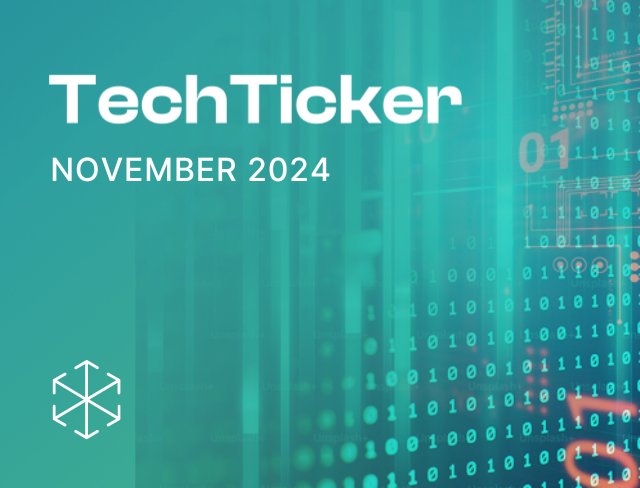The great Indian general elections are here! In this special election edition of the TechTicker, we cover how technology has changed electoral processes over the past few years, how it is reshaping elections in India and how it is becoming a key priority area for political parties. We also analyze tech-related promises that major political parties are making. Let’s dive in!
Tech-tonic shift
It’s election season in India (and 60+ other countries!). As hallmarks of democracies, elections are all about the people’s mandate and, in many ways, a report card for political parties. Since India began conducting free general elections in 1951, the voter base has drastically increased from 173 million to 969 million in 2024. Apart from numbers, elections have undergone significant transformations in what they signify and how they are conducted. And technology lies at the very heart of driving this change.
Technology has brought efficiency and transparency to the election process. Over the years since independence, we have come a long way from paper ballots and manual counting. From deploying drones to safeguard the peaceful conduct of the democratic process to utilizing online platforms and mobile apps for voter registration drives, technology is enabling a free(er) and fair(er) election. Another facet where we see a radical uptick is election outreach on social media. Unskippable political ads on YouTube and Spotify are all a testament to the fact that every political campaign must have a social media presence. While social media facilitates a direct dialogue between those in power and citizens, it has some downsides, with political parties now sliding into your DMs unasked with their manifestos, political vision and long messages about what they can do for you.
The 2024 elections, brought to you by AI
No longer is a conversation on technology and elections complete without talking about Artificial Intelligence (AI). While the 2019 election was labelled ‘the WhatsApp election’, the 2024 elections will probably be remembered as ‘the AI election.’
Concerns about AI-generated deepfakes started gaining traction in February 2023 when the IT Ministry released an advisory that directed intermediaries to ‘weed out’ deepfakes. Since then, it has released several advisories (in November, December 2023 and March 2024) on misinformation and deepfakes to tackle their proliferation to protect the integrity of the electoral process. The difference between WhatsApp forwards powered misinformation and AI-generated misinformation is that the verifiability remains much higher than our present ability to detect and distinguish AI-generated content. It's worth noting that deepfake technology is becoming increasingly sophisticated - AI development over the past few years has made it almost impossible to differentiate content without digital forensic audits. To combat electoral misinformation, the Election Commission of India (ECI) has also launched a ‘Myth vs. Reality’ portal on its website that helps voters navigate through common fake narratives related to the electoral process.
While the threat of AI-powered deepfakes spreading misinformation is high, it’s not all bad. Election campaigns have found innovative uses of AI, such as translating speeches into multiple languages and creating digital avatars of leaders to increase their outreach in a fun and engaging way. Political parties hope this will impress the 1.8 crore+ Gen-Z first time voters. For the older generations, AI is also raising people from the dead with recreations of political speeches from leaders who have long passed on!
Model behavior on social media
Throughout the elections, social media and messaging services become arenas where political parties test out fresh methods of creating and disseminating content. Until the 2019 general elections, the Model Code of Conduct (MCC) largely concerned itself with physical campaigning. Then, in 2019, the ECI extended the rules applicable to the physical conduct of elections to the digital sphere. The ECI, along with the Internet and Mobile Association of India (IAMAI), Facebook, Google, Twitter and other platforms, published a “Voluntary Code of Ethics for the General Election 2019” (VCE) to regulate the use of platforms for online campaigning by political parties. The Voluntary Code calls for participating platforms to monitor and regulate content and advertisements published/circulated by political parties while balancing freedom of expression. It requires platforms to create policies and mechanisms that facilitate access to information on electoral matters and train nodal officers at ECI on their products/ services. Check out our overview of the VCE and other ECI’s social media guidelines here!
In 2019, upon the ECI’s request, platforms took down over 900 social media posts. So far, reporting suggests that the ECI has requested X (formerly, Twitter) to take down posts for MCC violations. While X did take them down, it disagreed with the ECI’s request and called for the freedom of expression to extend to political speech. This is a concern that other platforms echo - how to balance the freedom of speech and expression against decisions made by the ECI on content that violates election norms. Given the chilling effect on speech associated with content takedowns on digital platforms, there is a large potential for deadlocks between the ECI’s request to takedown content and a platform’s efforts to sustain the freedom of speech and expression.
On April 8th, 2024, a coalition of eleven prominent civil society organizations, including the Association for Democratic Reforms, Internet Freedom Foundation, and Common Cause wrote to the ECI highlighting a lack of oversight regarding political expenditure on surrogate advertising and targeted online campaigns, urging the ECI to adopt internationally accepted standards for regulating the same. The coalition also recommended that the ECI implement a MCC specifically for social media, mandate political parties to disclose digital activities, monitor online political ad spending, enhance institutional capacity, tackle disinformation, and protect voters from surveillance.
While disclosing the digital activities of political parties remains a suggestion at the behest of the ECI, many political parties have disclosed their take on tech policy through their manifestos. We have covered this in our LinkedIn series examining the intersection of elections and tech policy. Here are some more interesting trends we observed that give us an insight into how the political decision-makers of our country foresee our digital future.
Manifestos become tech-savvy
Tech policy has finally found its way into political promises across the manifestos of the BJP, INC, the CPI(M), and several state parties. Even then, the manifestos lack a detailed tech policy vision, pointing to the possible continuation of the technocratic approach to tech regulation. While different parties have taken varied approaches, government schemes and projects that have seen an increase in focus and budget allocation in the last few years are the flagship promises of the BJP. For instance, the success of Chandrayaan 3 and increased outlay in ISRO’s budgets has moved the goalpost in the BJP manifesto to more ambitious space projects such as the Gaganyaan, the Bharatiya Antariksha Station (BAS), and developing an India-specific space economy. A look at the increase in the budgetary outlay in national projects such as the National Quantum Mission (NQM) and India Semiconductor Mission would explain why these have been called out as national priorities.
Tech leadership
The BJP's manifesto doubles down on the Prime Minister's ambition to lead the Global South in technology adoption and regulation. Whether exporting India’s Digital Public Infrastructure, catalyzing AI Innovation or leading multilateral forums in shaping the global tech ecosystem, the BJP looks to build on India’s geopolitical stature developed during its G20 and GPAI presidencies. The INC manifesto also promises to strengthen India’s role in multilateral institutions but does not comment on this intersection with the tech sector.
Eye for entrepreneurs
The BJP has continued its focus on start-ups and MSMEs. The party's commitments include bolstering the startup ecosystem with enhanced funding, mentorship programs, and government procurement support. These promises, coupled with announcements made by Union Minister Jitendra Singh regarding startup growth over the last decade underscore the BJP's focus on the start-up economy. The INC manifesto also recognises that the MSME sector is the creator of the largest number of jobs and promises to reduce their tax burden- including the controversial ‘Angel Tax’ introduced during last year's budget. The manifesto pledges to restructure the Fund of Funds Scheme for start-ups and support the use of emerging technologies such as AI and robotics to generate employment through more MSMEs and start-ups.
Looking at past laws
The opposition parties' manifestos such as INC and CPI(M) have approached tech legislation through a citizen’s rights perspective, exploring how these new-age tech laws impact the state-citizen relationship. For instance, the Telecommunications Act, of 2023 is criticized for impeding the freedom of speech and expression, and the Digital Personal Data Protection (DPDP) Act, of 2023 and the Broadcasting Services (Regulation) Bill, 2023 are faulted for introducing digital censorship. These manifestos continue the parties' opposition in the parliament on both telecommunications and data laws and call for repeal or at least a relook into these legislations.
Sustainable commonalities
One aspect common to both INC and BJP is their focus on the environment and sustainability. Both parties are building on schemes and policies introduced in their respective government tenures. The INC is looking to revive the National Action Plan on Climate Change introduced in 2008, and the BJP aims to augment environment protection through various schemes their government introduced like PM Surya Ghar Yojana, Railway Electrification, PM e-Bus, promotion of EVs, Ethanol, and Bio-fuel promotion among others.
The increased engagement on tech issues and sustainability challenges through these manifestos is a positive trend for the Indian tech ecosystem. This shift reflects a growing recognition of technology and sustainability’s pivotal role in shaping policy agendas.
Looking ahead
From election processes to election manifestos, tech has taken over. Along with infrastructure and social welfare promises that take the spotlight during election season, we are witnessing new-age promises related to technology development. Technology is now intertwined with various aspects of governance, economy, and society, prompting political parties to incorporate technology-related agendas into their manifestos to stay relevant and address the evolving needs and aspirations of the electorate. The focus is on improving efficiency - such as using AI to better predict weather and soil conditions for farmers or onboarding MSMEs onto e-commerce platforms. However, technology becomes the star of the show when it comes to aspects such as improving research and development capabilities, becoming a hub for emerging technologies, and tech-diplomacy. The BJP’s 100-day agenda post-elections, for example, highlights priorities towards becoming a semiconductor and chip manufacturing hub and developing deep-tech for defense. With discussions on the Digital Personal Data Protection Rules, Digital Competition Bill and Digital India Bill in the continuum, it is also likely that over the next 3 months, we will see a lot of movement on tech regulation.
That’s it from us. See you next month. If you enjoyed reading TechTicker, do share it!










